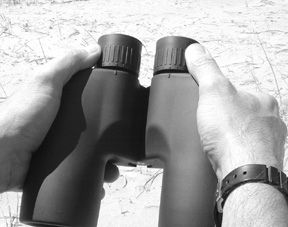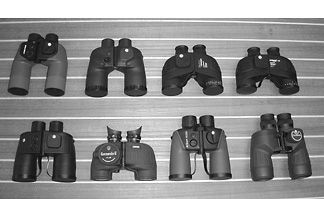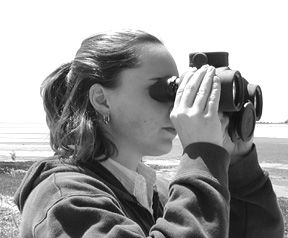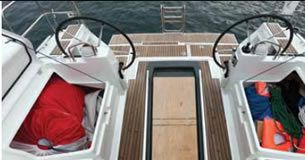Our last evaluation of 7×50 binoculars was back in December of 1996. More recently, we covered compact binoculars in March of this year, and were so cross-eyed from that group of 16 that we decided to return again soon to the more interesting field of the big light-gatherers. Binoculars rated at 7×50 are ideally suited for on-water use, and should probably be aboard any boat with space to stow them.

We’ve managed return engagements from over half of the brands rated in ’96, plus one newcomer-this time limiting our field to armored 7x50s featuring built-in compasses and claiming resistance to water. Limiting the field to binoculars with compasses was a good way to narrow the focus, if you will, but we also bore in mind a letter we got from a reader after our last hand-bearing compass evaluation (November 2002). He pointed out that binoculars equipped with a compass will stand in fine for a hand-bearing compass, and it’s true. Add a VHF radio and you have the nautical equivalent of the Ginsu Knife.
Revisiting Technical Matters
We included a fairly comprehensive treatment of binocular principles, terminology, features and attributes in our March issue. Please use it as background for the current discussion.
We’ll only provide details again here on the most critical points. The exit pupil, for example, is the shaft of light that emanates from the binocular, its size determining the maximum brightness of the image available to your eye. Divide the diameter of the objective lens by the magnification to get the diameter of the exit pupil.
All binoculars in this test have exit pupils of about 7.1 mm, which happens to be slightly larger than the scotopic (largest dark-adjusted) aperture of most any eye-meaning the eye can receive all the light thats in the scene.
Lenses are coated with microscopically thin layers of chemicals to improve light transmission. Since coatings are wavelength-sensitive, lenses are typically multi-coated to increase coverage. Coatings account for the various colors we see when we shine a light on the lens. By selecting a certain mixture of coatings it’s possible to “tune” a binocular for a particular use, but Steiner is the only maker to mention this.
Dioptric Adjustment allows each tube’s lens ensemble to be tailored for the acuity of the eye to which it will supply light.
A tripod socket allows the binocular to be attached to a standard photographic tripod via the standard 1/4″ screw thread. An adaptor will have to be purchased as an interface between the socket and the tripod, but instructions are silent on how to obtain one. We questioned one of the Internet binocular dealers and found that they are available for about $20. Since they’re a generic item, just check that the adaptor isn’t too wide to fit between the tubes of your favorite model.
Heinlein’s TANSTAAFL principle (There Ain’t No Such Thing As A Free Lunch) is still in effect: Compared to lighter daylight-type binoculars, you pay for the extra performance and features in terms of greater weight and bulk, plus a higher price tag.
How We Selected
Our goal was to sample the brands evaluated in 1996, plus any others that fit our criteria: enter seven of the eight models. We didn’t find any 7×50 armored, waterproof compass models by Minolta, Pentax, Swarovski or Zeiss. After testing was well underway we received a set of Steiner Navigator II 7×50 binoculars, but were unable to evaluate them side-by-side with the others. We did, however, give them a serious look, and think their optical performance is comparable to the Good or Excellent binoculars shown in the chart. If we omitted any eligible brands, it wasn’t for lack of searching. In any case, the current lineup is representative of the field.
How We Evaluated
We followed the same basic protocols used for the compact binoculars evaluation in March, with type-reading tests to probe the binoculars’ Optical Acuity. This time we moved a few feet closer to the test target to account for the slightly lower power of these models. In one location we used “bench” tests with the binoculars resting on a steady surface, as well as across-the- water tests. At another location the binoculars were hand-held for the type-reading test, and were also used to look across flat water, into the sun, and at numbers on cans and nuns running out a channel into the distance.
As before, Ease Of Use bundles together how well a model provides such mechanical factors as diopter adjustment, lens caps, eyeglass accommodation, user interface with compass feature, weight, attachment/use of strap, and even the case itself, especially whether it requires the binocular tubes to be folded in before insertion into the case: better than average (+), average (0) and worse than average (-) are the possible scores.
To augment raw optical performance, the Transparency rating attempts to convey how well the binocular “gets out of the way” and puts you in the scene you’re viewing: This includes brightness and clarity of image, low-light performance, including reaction to stray light from outside the viewed area, extreme-edge clarity, and probably a few others-all averaged into one rating, from a low of 1 to a high of 5.
Where provided, we report data supplied by the maker, including claims for water resistance (actually all the claims went beyond that, to waterproof). Where manufacturers’ claims were conflicting or didn’t make sense, we so noted under the individual discussions.
Each binocular’s Overall Rating summarizes claimed water resistance, optical acuity, length of warranty, Ease of Use and Transparency. Only after completing the evaluation did we look at each models price. Thus, ratings don’t carry the connotation of “for the money.” We tried to keep the scale more absolute.
Common Characteristics
All models have these features: armor, water-resistance, built-in compass, internal focusing, diopter adjustment, interpupillary adjustment, accommodation for eyeglass wearers, multicoated optics, and neck strap. All use porro-type prisms, as opposed to roof prisms. Some straps are claimed to provide flotation. We didn’t test this claim, but the one that seemed most credible was Nikon’s. All but one model had night illumination for the compass. Most models came with cases. All cases featured positive closure and a neck strap, and we considered most of them too soft and floppy.
All binoculars came with lens caps to protect all that copious glass, but we note some significant differences we found among them.
Most came with a tripod socket.
Compass Feature
The installation is fairly simple: A compass card floats in front of an index line, with primary light provided by a window on top of the barrel. Seven of the models have a battery-operated auxiliary light for taking night bearings, a handy feature on 7x50s, which seem to gather extra light at night instead of darkening. We tested the compasses along a north-south and an east-west line: In all cases, the bearings were within a 4 range. Also included is a distance-measuring aid in the form of a graduated reticle: Provided you know the height or width of the object whose range you want to know, you can use a formula provided to estimate distance.

So far so good; what’s not to like about these compasses? Well, don’t assume that “built-in” means unobtrusive-any more than the binocular itself would be if you stuffed it under your shirt. These compasses are at least partially mounted on the outside of the binocular tube, and some get in the way of your hand-which can easily cover the light-admitting window and darken the display. In addition, the compass steals some of the lower part of the viewed scene. As you focus on various ranges, the compass card and reticle may not stay in focus. As with other hand-held compasses, these need to be held near the horizontal; there’s no gimballing inside. Those handy auxiliary lights, of course, live on a diet of small batteries, and none of these models provides for compass adjustment. Look for individual comments in cases where a model differs from the above, and for battery specifications in the table.
Low-Light Performance
This is what most binocular users would consider a chief performance feature of the 7×50 optical formula. Each of these models enables vision in partial-shadow areas where compact binoculars would go black. The five whose daytime image exhibited better clarity and sparkle (Celestron, Fujinon, Nikon, Steiner, and West Marine) also did better in low light. One (Tasco) was slightly below average, and the other two were somewhere in between.
One of the models (Nikon) revealed an undesirable sensitivity to stray bright light (coming from outside the viewing frame) during night viewing. The West Marine was clearly less sensitive than average, and the least sensitive of all was the Steiner.
Low-light performance should obviously be given extra weight if you’re out often between dusk and dawn.
Center vs. Individual Focus
These eight models are a mixture of focusing-type availability: center-focus (CF) only, individual-focus (IF) only, and both. We don’t downrate IF binoculars here, because some people prefer them, they often cost less, and you can, with some effort, achieve the same results as with CF models. However, where cost isn’t a prime consideration, our preference is for center-focus binoculars, chiefly because they cut focusing time, effort, and frustration.
In using these glasses we found that if you first obtain sharp focus on an object 80-100 yards distant, you will be in acceptable focus (read on for qualification) from about 80 yards to well over a mile away. Beyond that distance, we found that atmospheric haze on the water has its own effects on image sharpness, and it wasn’t worth refocusing. By “acceptable” we mean satisfying typical on-board uses for binoculars. At close ranges, or where the binoculars will be stationary and you want the best they’re capable of, your focusing effort will increase proportionally-and it’s perhaps under these circumstances that CF shouldn’t be sacrificed simply to save money.
Optical Performance
As we said in March, we consider three performance factors optically critical in any pair of binoculars:
Lens quality – which turned out to be fairly consistent as measured by acuity. Differences in clarity and brightness were found among these models.
Light-gathering ability – these models provide about all your eyes can use, even in low light. Don’t mistake them for night vision goggles, but they do gather light and penetrate shadows.
Steadiness – more feasible with heavier models, and somewhat less critical with sufficient exit pupils. On a moving platform such as a boat, however, you’ll still be aggravated by having all this fine glass, yet unable to keep it as still as you’d like. We found that models with shorter tubes were generally more susceptible to shake. With no clear winners in the acuity category, we looked to composite ratings such as Ease of Use and Transparency, and found some key discriminators. See the following discussions and the table. At the end, we bring in price and nominate Best Buy.
The Binoculars
(alphabetically by brand)
Bushnell Marine #13-7500. Not distinguishing itself in either a negative or a positive direction, this model finished somewhere mid-pack. It passed the 9-point reading test by a squeak, and gave a somewhat milky/cloudy view. It is the only binocular in the group whose lens caps aren’t tethered-when you remove them you have to find a place to put them. On the more positive side, the instructions specify battery equivalents (unique in this group), and the individual-focus controls are well-marked and easy to operate.
Celestron Nautica #71189. See the Tasco evaluation, since these two models appear similar in many ways. In performance, although offering sufficient visual acuity, their field of view was partially obscured by a milky or cloudy appearance that we couldn’t trace to a lens smudge. The Celestron was slightly better than the Tasco in low light. The instructions informed us that Celestron was, until a year ago, owned by Tasco, which may account for some of the similarities. The Nautica 7×50 is offered in both IF and CF configurations.
Unlike the Tasco model, the Celestron comes with one of the best cases of the group. It’s rectangular and will stand upright and open by itself; it has fairly stiff sides and a wide strap. You can also carry it by means of a handle on the case top.
Fujinon Polaris FMTRC-SX. These glasses have olive-drab military armor and a no-nonsense traditional shape. Even the model designation has a military look. The letters tell us that this model has electron-beam-coated lenses, rubber armor, built-in (but unlighted) compass, and marine qualities of waterproofness, shock and impact resistance, as well as claimed flat-field performance across the lens surface. Their weight, at a hefty 55 ounces, contributes to that overall impression of ruggedness to a higher standard, while being so well-distributed that its only effect is to help steady the crisp, clear view they afford. These glasses pleased the eye in both their more-traditional appearance and the images they produced.
As with the Steiner, this model is only available in IF and does not come with a case (but one is available from the manufacturer).
Nikon OceanPro #7441. A smooth gray/black finish over its polycarbonate tubes gives this model an understated appearance, but everything’s there that’s needed. We found the tethers on the front lens caps a little stiff until we learned to push them downward as we removed the caps, a minor annoyance. Focusing was smooth and crisp, and the resulting images satisfyingly lifelike and three-dimensional. Weight and size felt good in the hands. The compass body protrudes above the tube, but it’s unlikely to snag or be sheared off.
The included case allows you to replace the glasses without changing IP angle, and the thick neck strap is claimed to provide flotation for the binoculars, a claim we’re inclined to believe. This binocular is one of only two marine 7x50s offered by Nikon. It was a quietly capable performer.

Steiner Commander V #392. The Steiner name carries considerable cachet among military and other serious binocular users, and for good reason. The company claims to have been the first to integrate a compass into a binocular. Its products are non-traditional in appearance, as though the drawing board is wiped clean at the start of each design. The glasses are said to be “absolutely mil-spec waterproof (tested to a submersion depth of 5 meters).”
While the binoculars themselves are easy to admire, a couple of Steiner’s claims take us into the red sector of the cognitive-dissonance zone. An example is the somewhat fatuous claim of having a “Sports-Auto-Focus. If you focus on an object at 50 yards, say the instructions, “all images from 20 yards to infinity will be bright, clear, and sharp.” Sorry, but the Steiners performed just the same as the other makes: By 100 yards the image started to get fuzzy, and at 120 yards a license plate could not be read. Even if this procedure worked as claimed, it would at most provide a kind of zone focusing, hardly automatic focusing.
Bombast aside, though, how did these binoculars do in practice? At 5″ these glasses are short, but quite wide (about 7″). They feel good in the hands, as long as you don’t try to grip over top of that compass housing. The tethers on the objective lens caps provide just the right amount of flex. Workmanship appears flawless, even when you look inside the lens tube from the front. The view through the lenses is satisfyingly sharp, with bright colors and a sense of transparency. The compass had a larger scale than most. Steiner offers neither this model nor any other 7×50 marine glasses in center focus.
No case is supplied. The included neck strap is very easy to attach/detach, but its proprietary connection limits you to using only Steiner’s straps. We also found its shortest length too long for us.
Swift Sea King #716R. Swift’s compact binoculars did very well in March, and so did these Sea Kings, although they weren’t at the very top of the heap.
One good feature is that these glasses are stored sideways in their case, offering the advantage of one-handed removal. The black armor has some grip surfaces molded in-another plus.
We found the lens-cap tethers unnecessarily stiff; they often blocked vision unless forced down and under the tubes. The instructions that came with these glasses were unusually complete within this group.
Swift sells other 7×50 armored glasses; the compass feature, however, is only available in individual-focus configuration. The IF focus references and “traction” are excellent.
Tasco Offshore 54 #OS54-1. See also the Celestron evaluation, since these two models are similar. The compass on these binoculars is equipped with both horizontal and vertical reticles to afford, in addition to bearings, distance to be estimated if either width or height of a distant object is known. As the manual points out, if you know one, you can calculate the other-and helpful scales are printed on one of the barrels to aid in the calculation. Our first evaluation sample was supplied with a defective compass. We notified Tasco of the defect, and the company sent another pair, whose compass worked fine.
Having squeaked by the acuity test, this was one of three models (the others being the Celestron and Bushnell) exhibiting a slight milkiness or cloudiness in the viewing field. It was also the trailing performer in low-light situations. Its case, although a bit soft, does commendably offer additional pockets and components.
Tasco, along with Bausch & Lomb, is owned now by Bushnell.
West Marine Tahiti #2677755. Externally similar to the Nikon model but exchanging gray for a bright blue, this model proved very competent. Objective lens caps are hinged from the bottom of the barrel, obviating the need for long tethers back to the central hinge-a good idea. Optically, images snapped into focus quickly and provided pleasing definition. The compass provides both horizontal and vertical reticles for rangefinding, but the reticle line was a bit thin in the area where the bearing is read. In low light this model was one of the three best performers, and also above average in rejecting stray light entering the tubes from outside the viewed area. The included padded strap is claimed to provide flotation for the binoculars. A bright blue padded case provides sufficient protection.
Conclusions
Most importantly, all models passed their acuity tests. None was clearly superior or inferior-even though a lens expert could no doubt find internal quality differences among them. The major variation we found among these binoculars proved to be in the Ease of Use and Transparency categories, thus affecting Overall Rating. Superficially, only the Fujinon has that submarine-commander look and feel; the rest are smooth, sleek, and modern, and some even have designer colors. As mentioned, we found the form factor to be of some practical interest: The shorter, thicker ones were slightly more difficult to steady than the longer, thinner ones.
The overall ratings in the table show four models rated Excellent: Steiner, West Marine, Nikon, and Fujinon, in that order. If low cost is a major concern, this narrows the list to the two Best Buys-West Marine and Nikon, which sell for less than half the price of either Steiner or Fujinon and are both center-focus.
Glasses of this size and price should fulfill high expectations. Luckily, it will be hard to go wrong within this group. Still, be choosy about the features that mean most to you-and only then look at the price tag.
Also With This Article
Click here to view “Value Guide: Binoculars.”
Contacts
Bushnell, 800/423-3537, www.bushnell.com
Celestron, www.celestron.com
Fujinon, 973/633-5600, www.fujinon.co.jp
Nikon Americas, 800/247-3464, www.nikonusa.com
Steiner (Pioneer Research), 856/866-9191, www.steiner-binoculars.com
Swift Instruments, 800/446-1116, www.swift-optics.com
Tasco, 800/423-3537, www.tasco.com
West Marine, 800/262-8464, www.westmarine.com







































